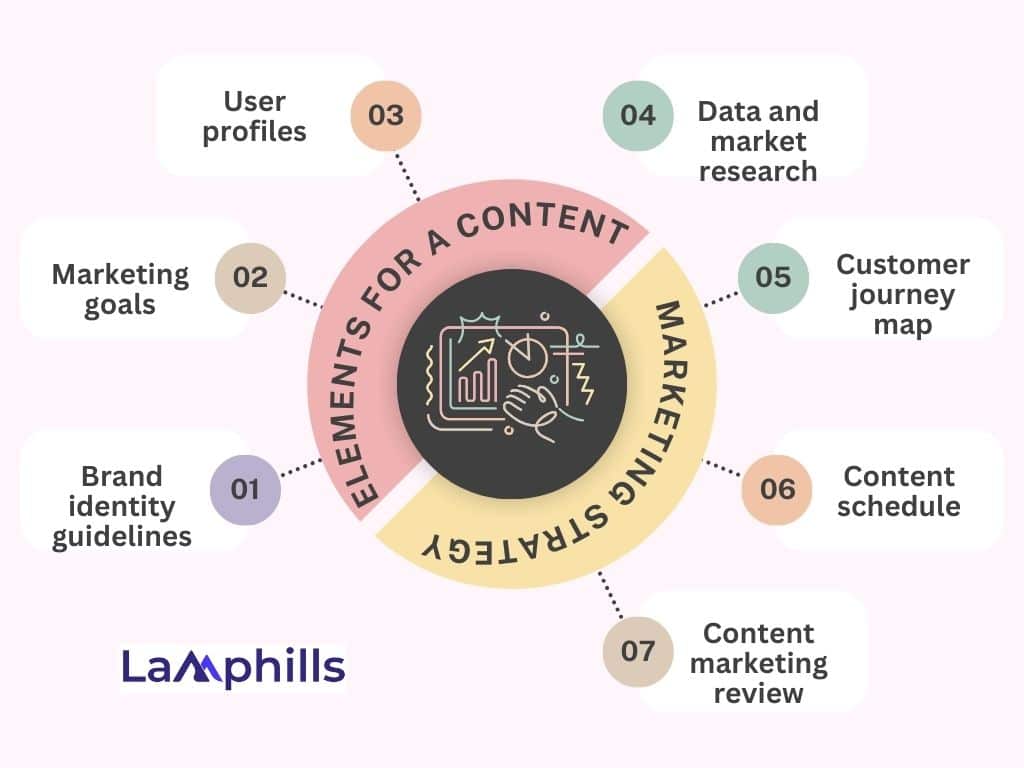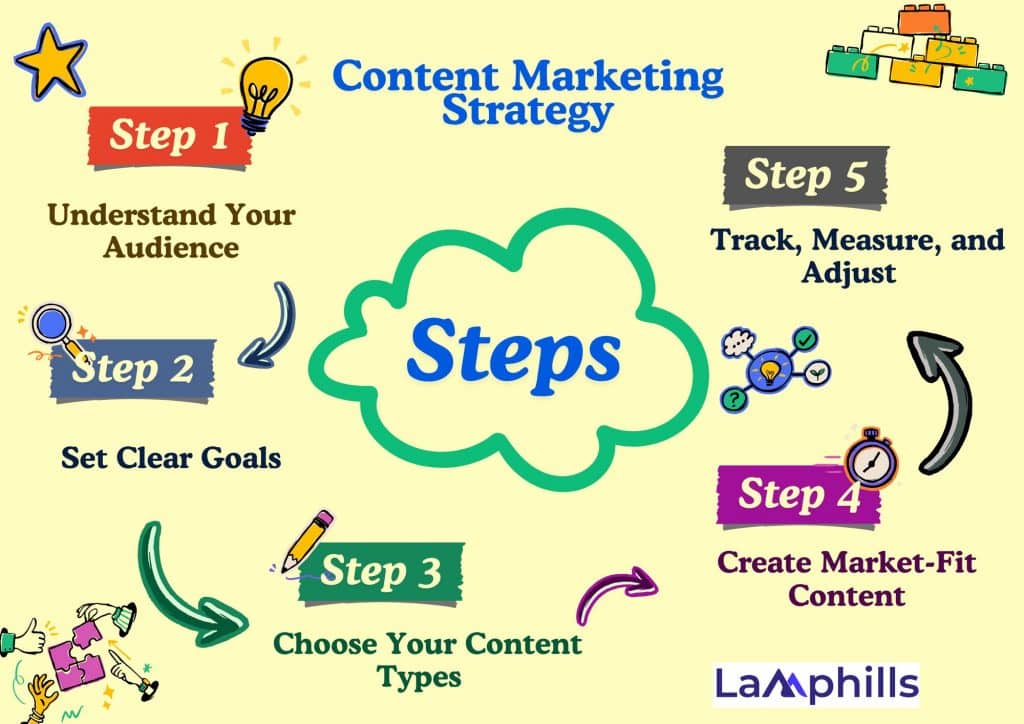A good content marketing strategy can help businesses connect with customers, engage them, and promote the company as the best in its field.
Over the years, while managing content for clients, I’ve learned how important a strong content marketing strategy is. It’s not about simply posting content or sharing updates randomly. Instead, it’s about crafting a thoughtful plan that keeps their brand message consistent and engaging. I’ve seen first-hand how a good strategy can transform a brand’s presence and help reach its goals effectively.
In this article, we’ll explore the must-have parts of a strong content marketing strategy and guide you through how to create one. Whether you’re new to content marketing or looking to improve your current plan, this guide will give you the key steps to connect with your audience and grow your business.
But first, let’s learn what a content marketing strategy is, why it’s important, and how it can help businesses grow.
Key Points
- A content marketing strategy is a structured plan that guides the creation and distribution of purposeful content to achieve business goals.
- It ensures your brand’s message remains consistent across all platforms, helping you build a recognizable and trusted identity.
- Understanding your target audience is crucial for content marketing success. User profiles allow you to tailor content that directly speaks to your customers’ needs and preferences.
- A successful strategy aligns content with every stage of the customer journey, guiding them from awareness to purchase while enhancing engagement and retention.
- A content marketing strategy includes a detailed content calendar, ensuring consistent, timely posts that help your brand stay relevant and visible.
What is a Content Marketing Strategy?
A content marketing strategy is a well-structured plan that guides how, when, and where you produce and distribute content. Rather than posting random pieces, a strategy ensures that your content is designed to achieve specific goals, whether it’s building brand awareness, driving traffic, or increasing sales. This approach transforms content creation from a reactive process into a deliberate and strategic one.
Think of content marketing as a conversation you’re having with your audience. You don’t just talk for the sake of it; instead, you ensure every conversation is meaningful, addresses their concerns, and provides value. That’s exactly what a good content marketing strategy does—it engages your audience with relevant and purposeful content at every stage of their journey.
I’ve used this approach to nurture relationships with my audience by offering helpful information and resources, all while aligning my content with my business goals. This targeted strategy made my efforts far more effective than just posting without direction.
You might think making this plan is hard, but it doesn’t have to be. You just need the right pieces. Keep reading this post to learn. But first, let’s see the key parts of a content marketing strategy.
Essential Elements for a Content Marketing Strategy

Effective content marketing plans have been a key factor in the success of many businesses. When you look closely at the marketing tactics of thriving companies, you’ll see how important content is and the different elements that contribute to its success. Focusing on your content plan could help your business grow significantly in the market.
According to San Diego, a content strategy expert, there are seven key elements of a successful strategy, and I have found these elements to form the foundation of any powerful content marketing strategy:
- Brand identity guidelines.
- Marketing goals.
- User profiles.
- Data and market research.
- Customer journey map.
- Content schedule.
- Content marketing review.
Now, let’s see how each of these parts helps make a content marketing plan successful.
#1. Creating Brand Identity Guidelines
Having clear brand identity guidelines before starting content marketing helps keep your brand consistent across different platforms. These guidelines show how your brand should look and sound, ensuring everything feels connected. Here’s how to build strong brand identity guidelines:
- Clearly define your brand’s key visual and verbal elements, like the logo, colors, fonts, images, tone of voice, and main messages.
- Give simple instructions for using each brand element, such as where to place the logo, how big it should be, and how much space to leave around it. For colors, list the main, secondary, and accent colors. For fonts, outline which ones to use, their sizes, and how to organize them.
- Set the tone of voice and writing style, like whether it should sound formal or casual, technical or friendly, and mention any words or terms to use or avoid.
- Include examples of both the correct and incorrect use of brand elements.
- Share the guidelines with everyone involved, including marketing teams, designers, and any outside agencies.
#2. Setting Marketing Goals

Image by gabrielle_cc from Pixabay
Creating marketing goals is important for content marketing because they provide focus, help track progress, and keep everything aligned. Clear goals show exactly what you want to achieve. For me, it’s always been about increasing engagement and driving traffic. Whether you want to build trust or generate leads, having specific goals will give you a sense of direction.
They also help marketers monitor progress, check performance, and make informed decisions to improve efforts. Here’s how you can set goals for content marketing:
- Define your main business goals, like increasing sales, expanding your customer base, building brand awareness, improving customer loyalty, or introducing new products/services.
- Identify specific targets, such as boosting website traffic, generating leads, growing your email list, increasing social media activity, or improving conversions.
- Think about your audience’s needs, likes, and habits.
- Set key performance indicators (KPIs) to measure progress and keep track of them.
- Use industry standards and past data (if you have any) to see where you’re starting from.
- Prioritize your goals based on what’s most important and possible to achieve.
#3. Creating User Profiles
Making user profiles helps businesses understand their target audience by outlining their age, interests, needs, and behaviors. With these profiles, marketers can design content that speaks directly to their audience.
User profiles also help businesses focus their efforts on what matters most. By addressing specific audience needs, businesses can boost engagement and conversions. Here’s how to create user profiles for marketing:
- Do research to collect data about your audience, like their age, gender, location, job, interests, challenges, goals, and habits.
- Look for patterns and common traits within your audience. This helps you create separate profiles for different groups.
- Define each profile with clear details about their key traits and characteristics.
- Double-check your profiles by comparing them with more research or asking for feedback from current customers or your target audience.
- Use these profiles in your planning and strategy. They can help guide decisions about content creation and distribution.
#4. Collecting Data and Doing Market Research
A group of engineers, scientists, and developers gathered around a brightly lit table in a tech research center to discuss and solve problems related to engine design.
Collecting data and conducting market research are important for content marketing because they help marketers understand the target audience. This, in turn, lets marketers create relevant and useful content, such as articles, blogs, or social media posts, that interest their audience.
By knowing things like audience age, preferences, and behavior, marketers can create better strategies, track performance, and stay ahead of competitors. Here are some tips for doing data and market research for content marketing:
- Set Clear Goals: Decide what specific information you want to gather.
- Find Data Sources: Use primary methods like surveys, interviews, or focus groups with your target audience. Also, secondary sources like industry reports, market studies, customer reviews, and social media analytics should be used.
- Analyze Demographics: Use tools like Google Analytics, social media platforms, or customer management systems (CRM) to examine factors like age, gender, location, education, and income.
- Study Audience Behavior: Understand what your audience prefers, likes, and does online.
- Follow Industry Trends: Stay current with industry news by reading articles, joining forums, and participating in discussions.
- Check Out Competitors: Look at how competitors are doing their content marketing.
- Review and Use the Data: After gathering the information, find patterns and trends to build a strong strategy.
#5. Helping Customers Through the Journey
A customer journey map is important in content marketing because it shows the full customer experience, from learning about a product to making a purchase. This map helps marketers understand what customers need, like, or struggle with at different stages.
By matching posts and articles to the customer’s journey, marketers can improve engagement, increase sales, and keep customers coming back. Follow these steps to create a customer journey map:
- Learn about your target audience by creating detailed profiles of them.
- Identify all the ways customers interact with your brand, such as through website visits, social media, emails, or customer service.
- Break the customer journey into stages: awareness, consideration, decision, purchase, and after-purchase.
- Gather information at each stage through customer feedback, surveys, analytics, and testing.
- Use visuals like diagrams or infographics to show the customer journey.
- Get feedback from customers, team members, or other stakeholders to make sure the map is accurate.
#6. Using a Content Calendar
A content calendar helps you stay organized and plan your content effectively. It ensures that your posts are consistent, timely, and well-coordinated with your team.
A content calendar is like a visual plan of your scheduled posts, making things run smoother and holding everyone accountable. Here’s how to make one:
- Set your content goals, know your audience, and decide on key messages and themes.
- Pick a calendar format that works best for you—this could be a simple spreadsheet, a project management tool, a calendar app, or even a physical calendar. Make sure it’s easy to update and share with your team.
- Create a calendar template with sections for titles, keywords, content types, audience, publishing dates, platforms, who’s responsible, and progress status.
- Mark key dates, like holidays, product launches, or industry events that are important to your business.
- Plan your themes and topics for each month or quarter, keeping in mind what interests your audience and supports your goals.
- Set publishing dates and times to keep your content flowing regularly and ensure it gets maximum visibility.
- Assign tasks to your team for creating, editing, designing, and sharing the content.
- Review and update the calendar often. Make changes based on data and how well the strategy is working.
#7. Analyzing Content Marketing Strategies
Content marketing analysis helps you see how well your efforts are working. This involves tracking key numbers like engagement (likes, shares, comments), conversions, and reach to understand what content connects with your audience. With this data, marketers can make smart decisions and ensure their strategies match their goals.
By analyzing strategies, marketers can track the return on investment (ROI) of their work, helping them use resources wisely. Content marketing analysis is easy if you follow these steps:
- Set key performance indicators (KPIs) like website traffic, engagement (likes, shares, comments), conversion rates, email open rates, and social media reach.
- Collect data from different sources, such as website analytics, social media platforms, email marketing tools, and customer feedback.
- Use tools like Google Analytics, social media insights, and email software to track your performance.
- Break down your data based on factors like content type, channel, audience, or time period.
- Watch your competitors to see what works for them. Study their successful strategies and popular topics.
In summary, a good content strategy brings together clear goals, an understanding of your audience, a plan for creating valuable content, and a way to measure success. By setting objectives, knowing who you’re talking to, delivering useful information, and tracking results, you can make sure your content connects with your audience and helps achieve your marketing goals.
Now, let’s see how to actually create a content strategy.
Steps to Creating a Successful Content Marketing Strategy

If you’re looking to develop your own content marketing strategy, here’s a process that has consistently worked for me:
#1. Understand Your Audience
I’ve realized that the more you know about your audience, the more relevant your content will be. Understanding their interests, challenges, and needs has allowed me to create content that resonates deeply with them.
Before you start creating a content marketing strategy, it’s important to know your target audience. Many businesses think their audience is anyone interested in their services. While that’s partly true, it’s too broad to build a focused plan.
If you try to target everyone, your strategy won’t be effective. Instead, focus on a specific group of people. Aim for a niche market—it will help you compete better.
Knowing your audience saves time and money. It allows you to connect with potential clients more easily and grow your business faster. To understand your audience well, look closely at your existing customers and learn what they like.
Note: When you speak directly to what your audience cares about, your content becomes much more engaging.
#2. Set Clear Goals
To make your content marketing strategy successful, you need clear goals. Without them, your plan won’t have direction. For me, it’s always been about increasing engagement and driving traffic. Whether you want to build trust or generate leads, having specific goals will give you a sense of direction.
Every business should set specific goals for its marketing plan. The clearer your goals, the better your results will be, and you’ll be able to track them.
What a business wants from its content marketing depends on its stage. A new business may wish to generate more leads, while an established company may aim to boost its market authority. As the market changes, your goals will also shift.
Once your goals are clear, you can develop your strategy and see great results.
#3. Choose Your Content Types
The next step is to decide what kind of content you’ll create. There are many options to choose from:
- Blog posts
- Videos
- Podcasts
- Ebooks
- Infographics
How do you pick the right ones? Your decision should be based on your goals and what you know about your audience.
For example, let’s say we focus on blog posts and videos. These formats help us reach our goal of getting more traffic from search engines.
Also, our audience research shows they prefer videos on YouTube and blog posts from websites.
#4. Create a Customer Journey-Focused Strategy
Focusing on the customer journey is a key part of shaping your content marketing strategy. You need to adjust your content based on the different steps your audience takes before making a purchase.
The customer journey includes stages such as exploring, learning, comparing, engaging, experiencing, and giving feedback. It’s important to understand each stage and create content that supports customers at every step.
By doing this, you can attract leads and turn them into customers. If you ignore any stage, your customers might feel lost and not complete their journey. So, make sure your content aligns with their entire experience.
#5. Keep a Consistent Brand Voice
A consistent voice for your brand helps build a strong connection with your audience. It also helps people recognize your content and understand who you are as a brand.
Creating a style guide is one way to keep your brand voice consistent. This guide ensures your content looks and sounds the same across all platforms.
A consistent voice improves your brand’s image and reputation. To achieve the best results, communicate your vision clearly with your content team.
#6. Create Market-Fit Content
As a content marketer, it’s essential to focus on your customers, but it’s just as important to keep an eye on the market. While you must support your customers at every stage, you also need to stay updated on changes in your industry.
Pay attention to the content being shared and how people respond to it. Research your industry thoroughly and understand what your customers need. Also, watch how your competitors present their content and the formats that engage their audience. This will help you adjust your efforts to align with the market.
Your main goal should be to deliver quality content across multiple platforms. Repurpose your content to stand out and bring value to the conversation. Create content that fits the market’s needs well.
#7. Monitor Your Competitors
Another key part of your content marketing strategy is tracking your competitors. Competitor research is highly valuable for any business.
Pause for a moment and look at what your competitors are doing. Check their strategies, approach, and the length of their content. See what types of content they’re using to attract their audience.
You might discover some great ideas during your competitor research. Their strengths can inspire you, and their weaknesses can present opportunities for you to shine. Focus on creating longer content, which tends to perform better on Google and can help attract more backlinks.
#8. Create a content calendar

Image by F1 Digitals from Pixabay
A content calendar is the backbone of a successful strategy. It’s allowed me to stay organized and keep my content consistent. Without a calendar, you might struggle to keep up, but content production becomes seamless with one.
Just like a social media calendar, you should have a calendar for your content, too. It helps you plan ahead and ensures your audience has time to review your previous content before getting new updates.
The content calendar will help you stay organized and plan for the future. You can prepare in advance for special occasions, holidays, and even slower times.
Including your social media posting schedule as part of your content strategy is also a good idea.
#9. Track, Measure, and Adjust
After publishing content, I regularly check its performance. Analyzing what works and what doesn’t has helped me fine-tune my strategy for even better results.
Here’s how you can do this:
- Track: Monitor the success of your content. This means examining the number of people visiting your site, watching your videos, or sharing your posts.
- Measure: Check the numbers. Look at key data, like the number of views, clicks, or sales your content is bringing in. This will help you understand what’s working and what’s not.
- Adjust: Based on what you’ve learned, make changes. If something is working well, do more of it. If something isn’t, change your approach to improve the results.
By doing this regularly, you can keep improving your content and reach your goals more effectively.
Here’s a bonus- I have put together a simple checklist that breaks down the key steps to guide you through the process. Whether you’re new to content marketing or looking to improve your current plan, this checklist will help you create a clear and effective strategy.
Download to find everything you need to get started!
Why Have a Content Marketing Strategy?
Creating content without a strategy is like wandering in the dark. You might stumble upon success, but it’s unlikely to be sustainable. With a strategy in place, I’ve been able to engage my audience and grow my business consistently. Here are a few reasons why having a content marketing strategy is essential:
#1. Focus and Efficiency
A strategy helps you stay focused and efficient. It saves time because you always know what content to produce and when. For me, this has been invaluable, especially when managing multiple content channels.
#2. Better Audience Engagement
When your content is tailored to your audience, they’re more likely to engage with it. I’ve seen higher engagement rates because my content speaks directly to my audience’s needs.
#3. Measurable Results
With clear goals and a strategy in place, tracking progress becomes much easier. I’ve found that measuring results not only motivates me but also helps me adjust my approach to stay on track.
#4. Consistency
A solid content strategy ensures that you’re regularly publishing high-quality content, keeping your audience engaged over the long term. Consistency is key, and having a plan ensures that your audience knows what to expect.
Bottom Line
In the end, a well-executed content marketing strategy allows you to connect with your audience in a more meaningful way. It’s not just about creating content; it’s about making sure every piece of content has a purpose. With the right strategy in place, you’ll not only see better engagement but also long-term growth for your business.
Frequently Asked Questions
What is a content marketing system?
Content marketing is a way to attract, engage, and keep customers by creating and sharing useful articles, videos, podcasts, and more. This strategy helps you show your expertise, build brand awareness, and make sure people think of your business when they’re ready to make a purchase.
What are the 4 systems of marketing?
A marketing information system has four parts: the internal reporting system, the marketing research system, the marketing intelligence system, and the marketing models.
How to create a marketing system?
How to Build a Marketing System
1. Plan Your Strategy Before Taking Action.
2. Lead Your Customers Through Every Step – The Marketing Funnel.
3. Let Content Drive Your Strategy.
4. Build a Strong Online Presence.
5. Set Up a Steady Flow of Leads.
6. Focus on Converting Leads into Customers.
7. Stick to a Clear Schedule.
What is the difference between a marketing system and a marketing plan?
A good marketing system gives you the structure you need, while a well-planned marketing strategy helps you stay on track and move toward your goals.
How do market systems work?
How does the market system work? A market system works when someone who needs something meets someone who has it, and they make a trade. This trade can involve goods, services, or money, allowing both people to get what they need.
Similar Articles
Social Media And Content Marketing: Building a Winning Strategy
Branded Content Marketing: The Powerful Strategy Big Brands Don’t Want You to Know
E-commerce Content Marketing: The Explosive Strategy Disrupting Online Sales






